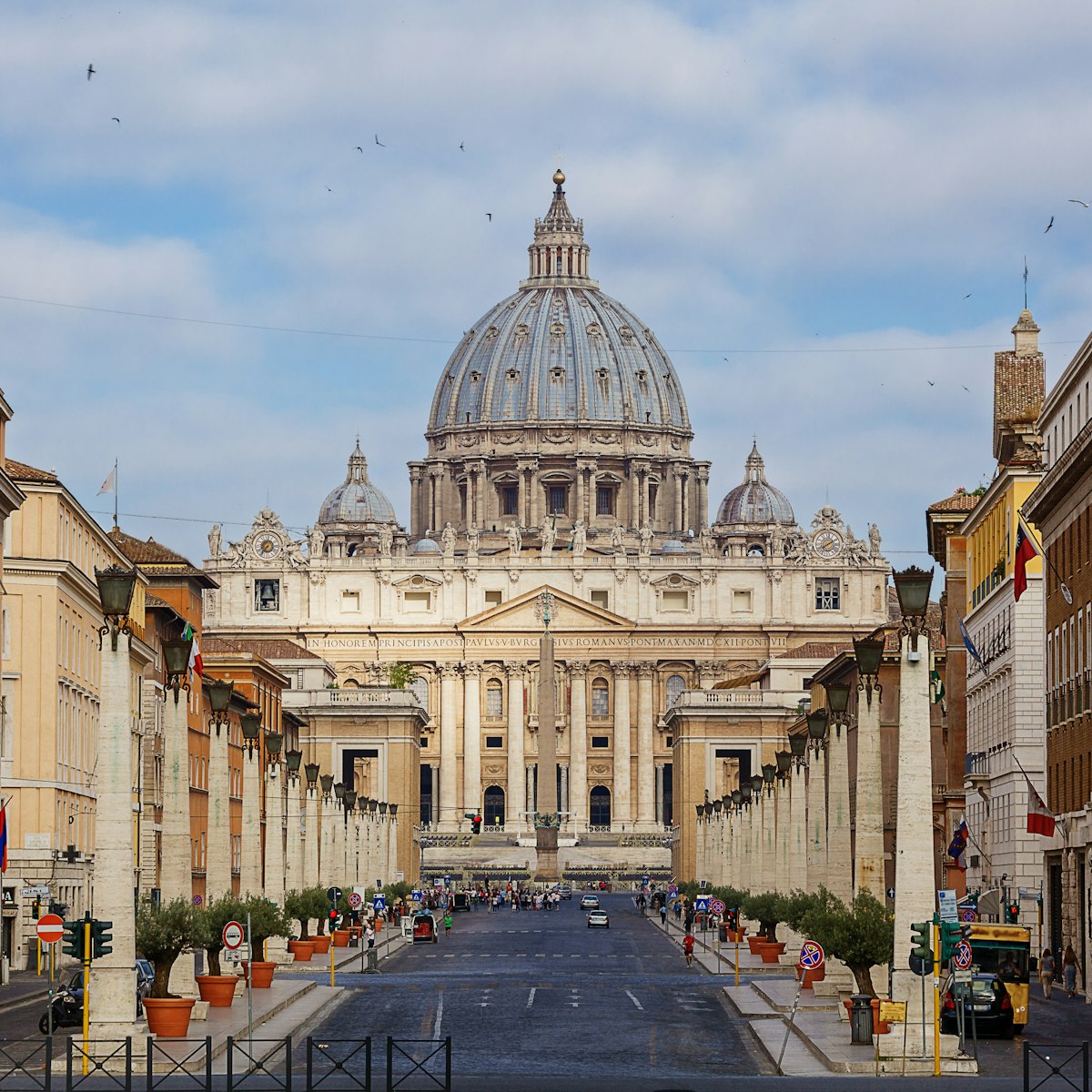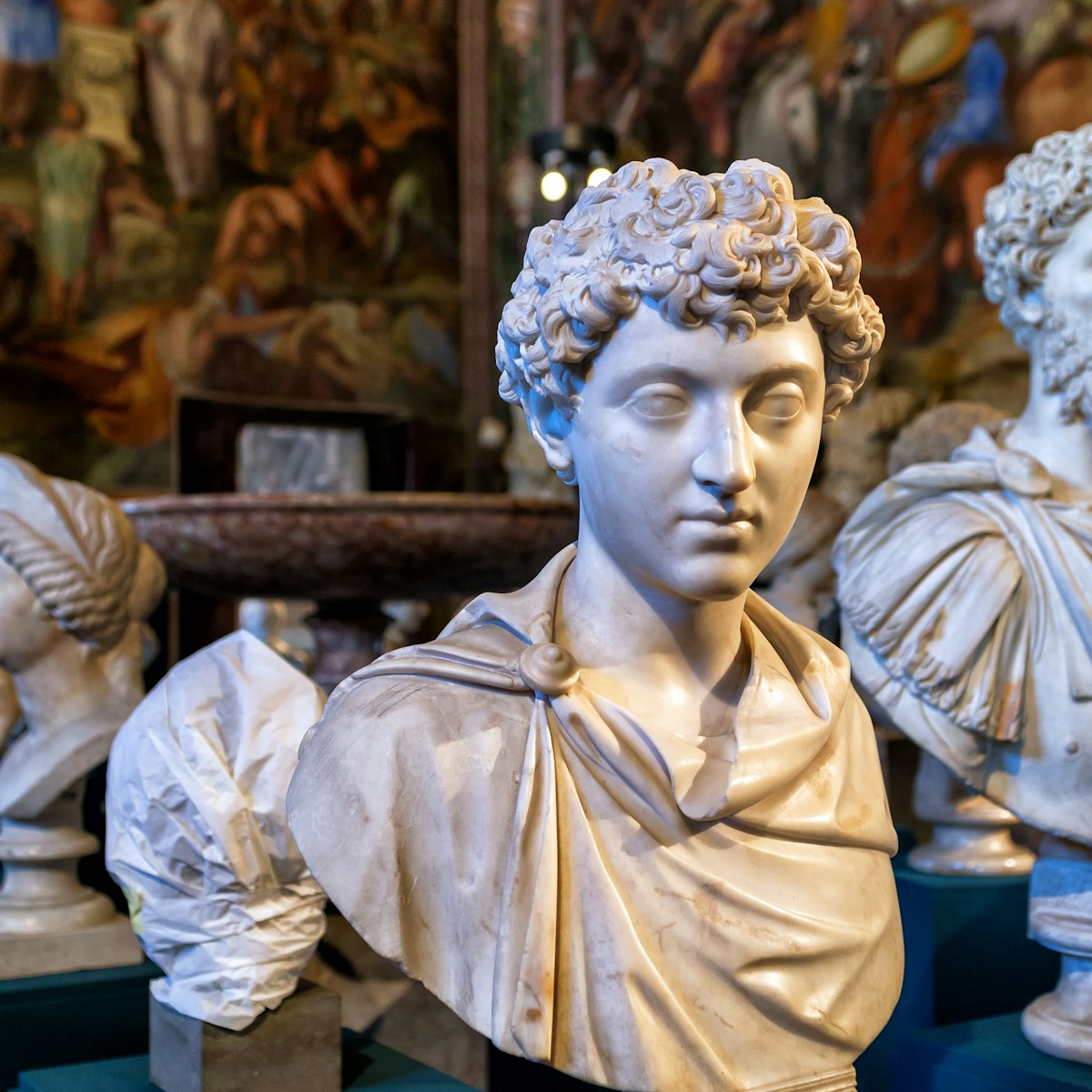Home to the Sistine Chapel and mile after mile of priceless masterpieces, the Vatican Museums (Musei Vaticani) are one of the world’s largest, busiest and most spectacular museum complexes.
The vast institution, made up of 26 museums and 7km (4.3 miles) of halls and galleries, houses the art and antiquities amassed by successive popes over the centuries. Highlights include a spectacular collection of classical statuary, a suite of rooms frescoed by Raphael, and the Michelangelo-painted Sistine Chapel.
Housing the museums is the lavishly decorated Palazzo Apostolico. This immense 5.5-hectare (13.6 acres) superstructure consists of two palaces – the original Vatican palace (nearer to St Peter’s) and the 15th-century Palazzetto di Belvedere – joined by two long galleries.
History of the Vatican Museums
The museums were originally founded in the 16th century by Pope Julius II to display the Vatican’s collection of classical sculptures. The first pieces were laid out in 1506 in the Cortile Ottagono (Octagonal Courtyard), where many remain to this day. Julius also commissioned two of the top artists of the age to work on the Vatican palace – Raphael to decorate his private apartments and Michelangelo to paint the Sistine Chapel.
Over successive centuries, the popes continued to add to the collections and open new museums. Major developments included the establishment of the Museo Pio-Clementino in the late 18th century and the opening of the Etruscan and Egyptian museums by Pope Gregory XVI in the 1830s.
More recently, Pope John Paul II oversaw a lengthy restoration of the Sistine Chapel and a museum-wide spruce-up for the year 2000 Jubilee.
The greatest hits tour
You’ll need about three hours to cover the museums’ greatest hits on this whistle-stop tour.
From the Cortile delle Corazze, head through the Cortile della Pigna to the Museo Chiaramonti. Don't stop here, but continue left, up the stairs, to the Museo Pio-Clementino where you’ll find the museums’ finest ancient sculpture. Chief among its many masterpieces are the Laocoön and Apollo Belvedere, both in the Cortile Ottagono (Octagonal Courtyard).
Finished there, work your way through a series of rooms to the Sala Croce Greca (Greek Cross Room), from where the Simonetti staircase leads up to the Galleria dei Candelabri (Gallery of the Candelabra). Push on through this to the Galleria degli Arazzi (Tapestry Gallery) and Galleria delle Carte Geografiche (Map Gallery), a stunning 120m-long hall lined with remarkable 16th-century maps.
At the end of the gallery, the one-way system funnels you through the Sala Sobieski and on to the Stanze di Raffaello (Raphael Rooms), a series of four rooms frescoed by the Renaissance maestro. The star turn here is La Scuola di Atene (School of Athens; 1509–11) in the Stanza della Segnatura but you’ll also find extraordinary works in the Sala di Costantino, Stanza d'Eliodoro, and Stanza dell'Incendio di Borgo.
Anywhere else these magnificent chambers would be the star attraction but here they’re the warm-up act for the grand finale – the Sistine Chapel.
Sistine Chapel
The jewel in the Vatican crown, the Cappella Sistina houses two of the world’s most famous works of art – Michelangelo’s ceiling frescoes (1508–12) and his Giudizio Universale (Last Judgment; 1536–41).
The 800 sq-meter ceiling design – best viewed from the far east wall – centers on nine panels depicting stories from the Book of Genesis. The most famous image, the Creation of Adam, shows a bearded God reaching out to touch fingers with Adam and so bring him to life.
On the west wall, the mesmeric Giudizio Universale (Last Judgment) shows Christ passing sentence over the souls of the dead as they’re torn from their graves to face him. The saved get to stay up in heaven while the damned are sent down to face the demons in hell.
Before exiting the chapel, take time to check out the frescoes on the side walls. Painted by a crack team of Renaissance artists, these include Botticelli's Temptations of Christ and Perugino's great masterpiece, the Handing over of the Keys.
With more time
You could add several extra stops. Near the Cortile delle Corazze, the Pinacoteca boasts a formidable painting collection that includes Raphael’s last work, La Trasfigurazione (Transfiguration; 1516–20), and Leonardo da Vinci’s unfinished San Girolamo (St Jerome; c 1482).
Moving on, the Braccio Nuovo (New Wing) of the Museo Chiaramonti features a celebrated statue depicting the river Nile as a reclining god covered by 16 babies.
For a change of period, the Museo Gregoriano Egizio (Egyptian Museum) displays finds from ancient Egypt and the Museo Gregoriano Etrusco (Etruscan Museum) showcases artifacts from the Etruscan tombs of northern Lazio.
Tickets, tours and practicalities
You’re not required to pre-purchase tickets but it’s worth it to avoid the notoriously long entry queues. Standard tickets, available directly at the museums’ entrance or online (plus €5 booking fee), cost €17. Demand is always high, so try to book as early as possible.
Official tours can also be booked on the website. Packages include guided visits to the Vatican Gardens (well worth seeing) and an exclusive after-hours tour of the Sistine Chapel.
The museums are open 9am to 6pm Monday to Saturday, and to 2pm on the last Sunday of the month (when they are free but horrendously busy).
Note that dress codes are enforced, so no uncovered shoulders, mini-skirts or short shorts.
Photography is permitted (without flashes or tripods) everywhere except the Sistine Chapel.
The best time to go
Realistically, there’s no surefire way of avoiding the crowds. As a rough guide, Tuesdays and Thursdays are the quietest days of the week; Wednesday mornings can be good too as most people are at the pope’s weekly audience. Afternoons tend to be less crowded than mornings.
Places to eat
In the museum, there’s a fine bistro in the Cortile della Pigna and several self-service cafeterias dotted around the complex.
Outside, head to the nearby Bonci Pizzarium for a taste of heavenly pizza al taglio (sliced pizza).










